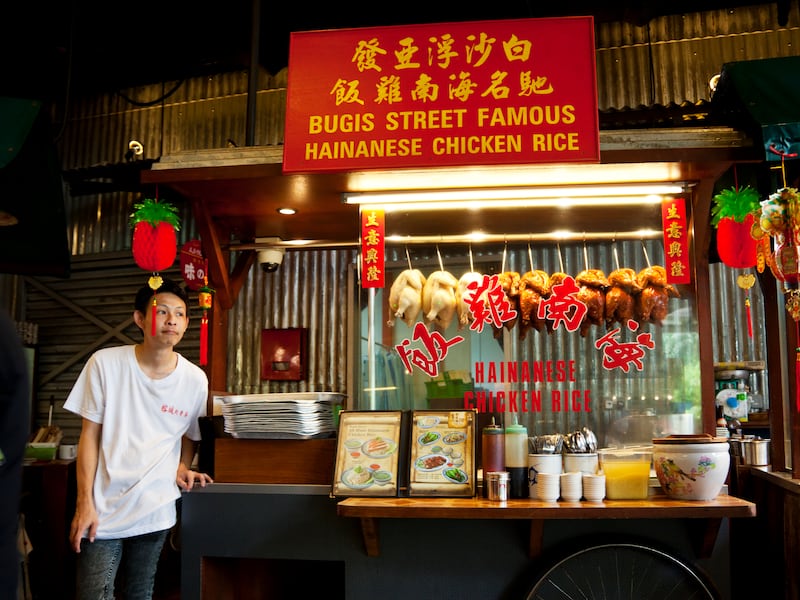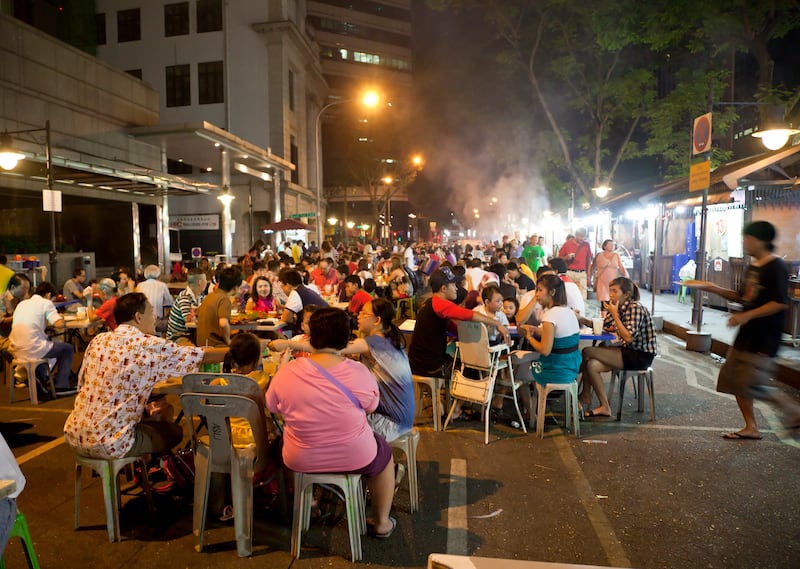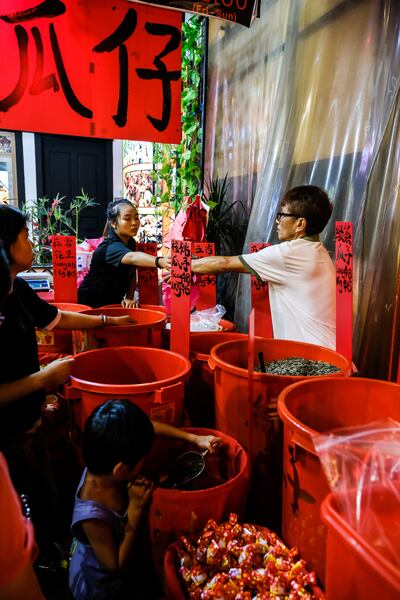After 16 hours in the air, the tedium of a Dubai transfer, food on tiny trays and movies on tinny headphones, we emerge dishevelled on the equator. It’s late, maybe too late for dinner, but tradition demands we christen our return to this city with satay at Lau Pa Sat, the grande dame of Singapore’s hawker centres.
Like Karl Brophy, who wrote so vividly about the city and its food in these pages last year, I am married to a local. Even by Singapore standards, Elish is quite the hybrid; Punjabi and Indonesian on her paternal side, grandparents from China and deepest Laois on the other. Twenty-five years since we first met, I am still getting my small parochial head around her genealogical geography, not least the long tail of its unique synthesis of Sikh, Taoist, Muslim and Christian beliefs. She sensibly identifies with all of them, and adheres to none.
By 2003 we were a “steady line”, my future in-laws were politely requesting an inspection of the Irish man, and Elish was keen to show me the place that had shaped her. Possessed of a characteristic Asian distaste for hoopla, she might have undersold the epiphany that awaited me 20 years ago on a hot December evening in Lau Pa Sat.
Yes, we ate on the street, but “street food” does not do justice to what has evolved in Singapore
Granted, I had heard tell of Singapore’s legendary hawker centres, but nothing quite prepares people from these latitudes for the sensory assault, the disorientation of your gastronomic compass and full-on food culture shock. I stood in the eye of its hexagonal structure, my eyes on stalks, struck mute in the 360-degree aromatic headmelt. Furious industry from tiny kitchens, the cacophony of 80 wizened cooks going hard at it, each specialising in a handful of dishes, sometimes just one. Steamy plumes issuing from brothy cauldrons, with notes of fat on wok and the rhythm of cleaver on woodblock. Lurid signs depicting a vast lexicon of Asian gastronomy about which you knew diddly, and prices to make a Dubliner cry out from our food wilderness.
The White Lotus review: Season three has its finger on the pulse to an almost excruciating degree
The fall and rise of Orla Kiely: ‘As horrible as it was, you just have to get on with it. There are things we won’t do again’
Competitive parenting in China: ‘School starts at 7.30am and I pick him up at 9.30 in the evening. We usually arrive home around 10pm. Then he studies again’
Everywhere a rippling flow of humanity jostling for tables. Stopover tourists having a gawk, westerners from the finance behemoths that like the corporate tax regime, but mostly locals, the improbable dolly mixture that has shaped Singapore cuisine – Chinese from the mainland, those from the straits called Peranakan, Malays, Indonesians, Indians, mostly Tamil, and enigmatic Eurasians of 16th-century Dutch and Portuguese descent. All babbling away happily, because even though it’s a quotidian ritual, the thrill of the hawker centre is forever young.
I am not the first Irish man to stand here. It was built originally as a wet market in 1838 from a frame prefabricated in Glasgow. Its Victorian wrought-iron filigree would not be out of place in the Iveagh or English Market, and its gaffer was from Louth. Young George Coleman left Drogheda to make his fortune in the east, and was the civic engineering brains behind Singapore’s transformation by its feted colonial founder Stamford Raffles. Irish heavy lifting is a familiar motif in many corners of the empire.

Over time the city’s Central Business District has soared around it, in this place where land is at an impossible premium. Each evening, a busy adjoining street is pedestrianised, elaborate pop-up grills are lit and Lau Pa Sat’s “satay club” opens for business. Like that first encounter and every trip since, we ate little skewers of marinated lamb, chicken, pork, prawns and squid, fired over fierce charcoal. We smeared it with sticky peanut sauce and alternated the protein with mouthfuls of lontong compressed rice steamed in banana leaf. We sluiced it down with freshly pressed sugar cane juice cut with the fragrant acidity of tiny calamansi limes. We sat at long communal tables nestled among the skyscrapers in the smoke-infused air of the equatorial night, and it was heaven, again.
Yes, we ate on the street, but “street food” does not do justice to what has evolved in Singapore, this marvel of the gastronomic world. Lau Pa Sat is open 24-7, nothing to see here in this city that toils, spends and eats around the clock. It’s a hawker centre, not to be confused with a scruffier kopitiam, meaning coffee shop, or a swankier food court, typically adjacent subterranean shopping malls. Here they build on a vertical plane that goes deep down as well as sky high. The scenery might change, but emblematic dishes such as chilli crab are always at hand, just like steak et frites in Paris whether you are in a brasserie, bistro or restaurant gastronomique. And if it’s ostentatious fine dining you hanker after, Singapore has oodles of it – 55 Michelin star restaurants at the last count.
But hawker culture, that’s where it's at; certainly in the eyes of Unesco, which decreed its intangible cultural heritage status in 2020. There are 118 of them now, more under construction. You’re never far from one on this tiny island of 5.5 million people, which you could plonk down in Ireland’s smallest county (Louth: population 128,000) and still have 50sq km left over.

Which hawker centre reigns supreme is anyone’s guess, but every Singaporean has an opinion. Loyalties run deep. We’re talking club GAA devotion levels here. I have eaten in many and loved them all, even the one in T3 at Changhi, which might be the tastiest, keenest-priced airport food you’ll ever eat. Expectations and word of mouth are such that below-par hawkers get found out very quickly. Standards are consistently high. Sometimes they are transcendent, as was the case in 2016 when Chan Hong Meng won a Michelin star for his solo rendition of Hainanese chicken rice, a dish he had been refining for decades. Now with a Hawker Chan empire that stretches from Taiwan to Kazakhstan, he lost the star in 2021. I doubt he is overly concerned, and finds great solace in his deserved wealth and leisure after 40 years’ graft in his Chinatown kitchen. Daughter Amalia and I gave it a whirl in one of his downtown joints. Can I say with certainty it was the pinnacle of chicken rice? I cannot, no more than I can say where you’ll find Dublin’s finest pint.
Like all spheres of Singapore life, the hawker centres are a model of regulation today, a far cry from the city’s wild years. That lasted until the 1960s, the narrow streets thronged with guerrilla vendors hustling cheap Chinese, Indian and Malay food from pushcarts. Lax sanitation and the tropics are not a healthy mix, but food, and everything else, was set to change with the ascent to power of a 36-year-old lawyer, Lee Kuan Yew, in 1959. Not for the first time, the British left behind a mess, and these were tense times on the Malaysian peninsula, as tumultuous as the decade we’ve just commemorated. When independence came in 1965, it was sink or swim for the fledgling state, but at its helm was one of the 20th-century’s most successful nation builders.
The early headwinds were as severe as anything Ireland experienced, but over the next 25 years, this promethean figure galvanised the young nation. The economic changes wrought under Lee’s premiership are universally lauded as miraculous, but it’s the social dividend that resonates most deeply for an Irish visitor. Eighty per cent of Singaporeans live in social housing, each pristine development umbilically connected to the MRT, the best public transport system I have ever ridden. Its education system consistently tops global rankings, and its citizens enjoy universal healthcare. There is no crime to speak of. Imagine.
Thus the municipal hawker centres are much more than places where hard-working Singaporeans can enjoy affordable and delicious food. It’s not all roses here, and many of the liberties we take for granted are suppressed. Freedom of expression is overly controlled, its governance is patriarchal, dynastic and domineering. The nanny state pokes around in places it has no right to be. Tensions simmer beneath the idyllic surface of this Faustian pact, but it turns out that if you truly honour the social contract and provide for your citizens’ most elemental needs, such as nutrition, housing, transport, schools and hospitals, the vast majority of them will tolerate your rules, however perverse some of them may be.
Singapore famously imposes the death penalty for possession of drugs, but here in August, people are brazenly consuming a stimulant that arguably should also be controlled. It’s peak durian season, and the city is in a tizzy for it, like Germans when the first white asparagus hits, or the French when gooey Mont D’Or arrives in the autumn. These things are passé compared with durian, the world’s most divisive fruit. Everywhere you are violently assaulted by its noxious perfume. Gloves are worn when eating it, hotels have banned it, and carrying it on the MRT incurs a hefty fine. Even harvesting it can be lethal, and it’s curtains if one of the 8kg fruits, complete with spiked exterior that looks like a medieval mace, should land on your head.
Durian fruit is one of nature’s most outrageous creations and quite bonkers
This malodorous brute eludes definition but plenty have tried. David Thompson, the great authority on Thai food, was reminded of the New York subway in high summer. Bourdain said your breath will smell like you snogged your dead grandmother, while for Anthony Burgess it was akin to eating raspberry mousse on the toilet. But travel writer Richard Sterling gets closest, opting for pig shit, turpentine and onions, garnished with a gym sock.
And yet, here in the heart of old Chinatown, it is durian party time, with excitable punters scarfing down its fleshy interior pods, which also have a foreboding, alien lobe je ne sais quoi. At every stall, the cognoscenti are arguing like sommeliers over the merits of this year’s harvest, its terroir and the distinctive flavours of the many varieties on offer, from entry level Red Prawn to the grande cru Musan King. I chat with a young French couple, getting a last fix before heading to the airport. They say the first time was repulsive, but now they have gone at it five days straight and are hopelessly addicted. Clearly commitment is required, like the first drag of a cigarette, a pint of stout or losing your virginity. Later that day I dip a toe in durian’s murky depths. I am not prepared for the sulphuric properties, the taste of alliums that overstays its welcome in my oral cavity. But I persevere, beguiled by its creamy, mallowy texture and its fleeting bliss point, where it feels like every known tropical fruit has simultaneously convened in your mouth along with a squirt of caramel and almond extract. It is one of nature’s most outrageous creations and quite bonkers.

That’s Singapore for you, a never-ending sushi belt of food discovery: delicious, revelatory, convivial, sometimes dislocating and just a bit weird. It doesn’t have a food identity, food itself is the identity, because other forms of expression can be tricky to navigate. Its Panem in The Hunger Games and Malaysia is its District 12, sending vast amounts of produce, including those durian, across the Singapore causeway where there are no farms and they rely on imports for 90 per cent of their food. It’s a city-sized lazy susan, groaning under the weight of dishes from every corner of Asia. Indonesia, Thailand, Malaysia, Vietnam, India, Japan, the many expressions of regional China – all are here. It’s a gastronomic Vegas, whether you want white Italian truffles in a gilded Michelin cage or a sandwich to go, as I discovered after stumbling upon an O’Briens franchise in a shopping mall some years back.
Our two small islands have more in common than the never-ending pursuit of a good sambo. Bound in our colonial past, we have bootstrapped our way to greater prosperity, we grapple daily with the politics of cultural identity and sensitive relationships with the neighbours. We share an eye for the opportunity, as small countries invariably must. Each time I go there, it helps me understand both places a little more. How good would Ireland be if we could submit to some of their zeal for spatial planning? How good would Singapore be if they could embrace a little of our permissiveness around the edges? I’m not sure I could live there, but I can’t wait to go back, for more durian and other conundrums.



















